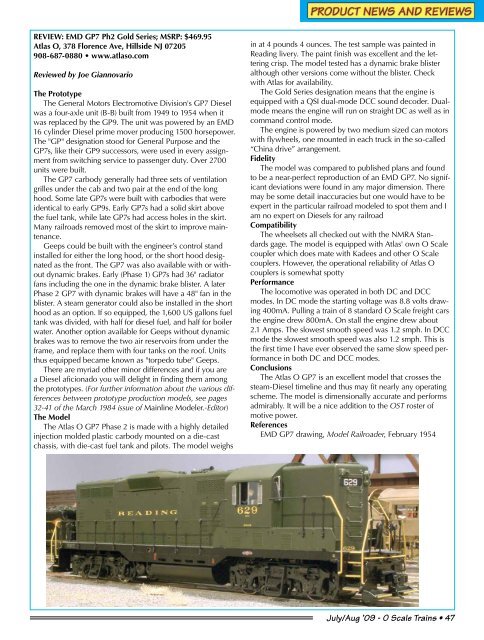Download - O Scale Trains Magazine Online
Download - O Scale Trains Magazine Online
Download - O Scale Trains Magazine Online
- No tags were found...
You also want an ePaper? Increase the reach of your titles
YUMPU automatically turns print PDFs into web optimized ePapers that Google loves.
REVIEW: EMD GP7 Ph2 Gold Series; MSRP: $469.95Atlas O, 378 Florence Ave, Hillside NJ 07205908-687-0880 • www.atlaso.comReviewed by Joe GiannovarioThe PrototypeThe General Motors Electromotive Division's GP7 Dieselwas a four-axle unit (B-B) built from 1949 to 1954 when itwas replaced by the GP9. The unit was powered by an EMD16 cylinder Diesel prime mover producing 1500 horsepower.The "GP" designation stood for General Purpose and theGP7s, like their GP9 successors, were used in every assignmentfrom switching service to passenger duty. Over 2700units were built.The GP7 carbody generally had three sets of ventilationgrilles under the cab and two pair at the end of the longhood. Some late GP7s were built with carbodies that wereidentical to early GP9s. Early GP7s had a solid skirt abovethe fuel tank, while late GP7s had access holes in the skirt.Many railroads removed most of the skirt to improve maintenance.Geeps could be built with the engineer’s control standinstalled for either the long hood, or the short hood designatedas the front. The GP7 was also available with or withoutdynamic brakes. Early (Phase 1) GP7s had 36" radiatorfans including the one in the dynamic brake blister. A laterPhase 2 GP7 with dynamic brakes will have a 48" fan in theblister. A steam generator could also be installed in the shorthood as an option. If so equipped, the 1,600 US gallons fueltank was divided, with half for diesel fuel, and half for boilerwater. Another option available for Geeps without dynamicbrakes was to remove the two air reservoirs from under theframe, and replace them with four tanks on the roof. Unitsthus equipped became known as "torpedo tube" Geeps.There are myriad other minor differences and if you area Diesel aficionado you will delight in finding them amongthe prototypes. (For further information about the various differencesbetween prototype production models, see pages32-41 of the March 1984 issue of Mainline Modeler.-Editor)The ModelThe Atlas O GP7 Phase 2 is made with a highly detailedinjection molded plastic carbody mounted on a die-castchassis, with die-cast fuel tank and pilots. The model weighsin at 4 pounds 4 ounces. The test sample was painted inReading livery. The paint finish was excellent and the letteringcrisp. The model tested has a dynamic brake blisteralthough other versions come without the blister. Checkwith Atlas for availability.The Gold Series designation means that the engine isequipped with a QSI dual-mode DCC sound decoder. Dualmodemeans the engine will run on straight DC as well as incommand control mode.The engine is powered by two medium sized can motorswith flywheels, one mounted in each truck in the so-called“China drive” arrangement.FidelityThe model was compared to published plans and foundto be a near-perfect reproduction of an EMD GP7. No significantdeviations were found in any major dimension. Theremay be some detail inaccuracies but one would have to beexpert in the particular railroad modeled to spot them and Iam no expert on Diesels for any railroadCompatibilityThe wheelsets all checked out with the NMRA Standardsgage. The model is equipped with Atlas' own O <strong>Scale</strong>coupler which does mate with Kadees and other O <strong>Scale</strong>couplers. However, the operational reliability of Atlas Ocouplers is somewhat spottyPerformanceThe locomotive was operated in both DC and DCCmodes. In DC mode the starting voltage was 8.8 volts drawing400mA. Pulling a train of 8 standard O <strong>Scale</strong> freight carsthe engine drew 800mA. On stall the engine drew about2.1 Amps. The slowest smooth speed was 1.2 smph. In DCCmode the slowest smooth speed was also 1.2 smph. This isthe first time I have ever observed the same slow speed performancein both DC and DCC modes.ConclusionsThe Atlas O GP7 is an excellent model that crosses thesteam-Diesel timeline and thus may fit nearly any operatingscheme. The model is dimensionally accurate and performsadmirably. It will be a nice addition to the OST roster ofmotive power.ReferencesEMD GP7 drawing, Model Railroader, February 1954July/Aug ’09 - O <strong>Scale</strong> <strong>Trains</strong> • 47
















